Garbage truck
A garbage truck (also garbage truck or garbage collection vehicle ) is a motor vehicle that is used in garbage disposal to collect waste from residential buildings, commercial and industrial companies and to transport it to a transfer station or a sorting or treatment facility.
For this purpose, the garbage truck has a structure on the chassis of a truck that consists of a device for loading, the dump and a loading space. To make better use of the cargo space, the garbage is usually compacted in the garbage truck.

In Germany and Austria, garbage trucks must be marked with an A-sign if waste is transported on public roads.
Overview
Different types of waste and recyclables are collected and transported with garbage trucks. For this purpose, the vehicles are equipped with suitable emptying and loading devices, which are geared on the one hand to the collection of containers and on the other hand to the collection of loose waste, especially bulky waste , and bags and bundles of recyclable materials. Container removal is common for household and commercial waste, with the containers being colloquially referred to as garbage cans or garbage cans . These containers, technically referred to as large waste containers (MGB), are available in sizes between 60 and 360 liters in 2-wheel design (for easier handling) and 660 to 1100 liters in 4-wheel design as roll containers.
For emptying a container with his will discharge receptacle (comb bar, pin, DU-recording) placed on the lifter of the refuse vehicle. The container is emptied mechanically with hydraulic lifting and tilting. The classic shape of a garbage truck is the rear loader, which is loaded and operated by one or more garbage collectors. To save (personnel) costs, loading systems are used that the driver can operate alone: front loaders (with overhead emptying for large-volume containers), side loaders and front-side loaders (for small-volume containers).
For the loose collection of bulky waste and recyclable materials, empties with a deep collecting basin, which is filled by hand, are common. A hydraulically operated press plate conveys the load from the tub into the hold and compacts it. Rotary drum (rotopress) and press plate systems are common for compression.
Krupp in Essen was the first to build a garbage truck. An inclined conveyor screw made it possible to meet the requirements for a larger transport volume and a low loading edge.
Vehicle types
Garbage trucks with rear loaders

Rotopress systems
Garbage trucks as rear loaders with the Rotopress system consist of a large rotating drum (up to 15 revolutions per minute), which is usually covered with a characteristic ribbed structure with a rounded top to reduce noise. Sometimes the cover is left out to reduce weight so that the drum is freely visible. The waste filled into the bulk material is transported inside the rotating drum through screw-shaped web plates on the wall (“screw conveyor”) and is slightly shredded in the process. A fixed, counter-rotating press screw on the tailgate also compacts the waste as soon as the drum is full. To empty the vehicle, the tailgate is opened and the drum is switched to reverse: The collecting drum is emptied similar to a concrete mixer .
The advantages of this system are the small number of mechanical and hydraulic parts as well as the small depth of the tailgate and the continuous operation. The disadvantage is the lack of further compression and the noise generated by rotating waste.
Rotopress vehicles are preferably used in urban areas, where garbage cans and small containers are primarily available for collection. Refitting of collection vehicles is not necessary here, so that these collection vehicles with their low maintenance effort can be used cost-effectively for large vehicle fleets.
Press plate systems
Refuse vehicles with a press plate system use a feeding press plate and a movable counter-shield in the press room of the collection vehicle. The waste is poured into the hollow of the bed and pushed by the press plate first inwards and then upwards into the vehicle body, where it is considerably compressed. The movable counter-shield inside the structure builds up the necessary counter pressure. As the vehicle becomes full, the counter-shield is shifted hydraulically towards the driver's cab, piece by piece, in order to free up more storage space. To empty the vehicle, the emptying is completely folded up so that the counter shield can push out the collected waste. The advantages of this system are the considerable compression of the waste and the versatility of the vehicle. Disadvantages are the maintenance-intensive and loud high-pressure hydraulic system and the high depth of the fill.
Press plate systems are preferred in rural areas and for the collection of larger containers as well as for loose waste such as bulky waste and for the collection of recyclable materials (yellow sack). The different fillings can be converted in a few hours.
Other systems
Press head vehicles, in which the filled waste is pressed by a pressing head swinging back and forth, are only rarely used today.
System vehicles are rarely used, the structure of which mainly consists of a removable, closed container and separate bulk material. The advantage of this system is the possible separation between the collection of the waste from the households by a specialized press vehicle and the further transport to a treatment center. This transport can be carried out inexpensively by any container transporter and result in cost advantages when transporting over longer distances. The disadvantage is the high purchase price of the overall system and the lower loading volume of the container.
As with roll-off tippers, the containers are unloaded by tilting them, and with heavily compressed contents, difficulties may arise in conveying the material out solely by gravity. Automated systems are primarily used in these collection systems: The bulk material detects the attachment of a garbage can by means of a weight sensor. This is then automatically lifted, tilted, jolted and put down again. This means that the vehicle can also be effectively filled by a garbage collector alone. Additional equipment on these vehicles also clean the garbage cans after emptying with water injected under high pressure.
Garbage trucks with front loaders
Garbage trucks with a front loader system are mainly used in commercial waste collection for large-volume containers. The containers are picked up by the driver with the front loader, heaved over the driver's cab and emptied into a dump behind it. The basic system is similar for the manufacturers, but differs in the storage of the mounting device. On vehicles from HN Schörling , the so-called lifting frame is placed on the roof while driving; it is found below the windshield in Heil vehicles and above the windscreen in Faun vehicles . The body is available in different sizes for the different chassis (3 or 4 axles).
The garbage containers have a size of 0.7 to 15 cubic meters, so that when emptying, total weights of up to 3.5 tons can be lifted over the driver's cab. The loading space is usually equipped with a press plate system with which the loaded waste is compacted. For unloading, the tailgate is opened upwards and the waste is pushed back out of the vehicle with the help of the press. To secure the load, there are two lids or a type of sliding blind on the roof that opens when the container is tipped and then closes again.
The vehicles can be equipped with weighing systems that either weigh the total weight of the waste under construction or weigh the individual containers so that weight-based individual billing of the customer is possible. The higher technical complexity of these vehicles with their electronic components and digital control means that more effort is required for maintenance and care.
Garbage trucks with side loaders and front side loaders
For emptying smaller garbage cans (MGB up to 360 liters), garbage trucks with side loaders have been developed in which the vehicle (like sweepers ) is usually designed as right-hand drive so that the driver can better control gripping the garbage cans. The containers are emptied with the side loader in a short way into the higher-lying bulk. No other employee is required to empty the garbage can, but the customer has to provide the containers in the correct position and also fetch them back.
With front side loader systems, the loading arm reaches up to 3 meters in front of the driver's cab. This charging system is also only operated by the driver. With this system it is possible to empty several smaller containers in one unloading process.
The Curotto Can retrofit system is also available for front loaders as an attachment for the front fork. This consists of a container with a side loader so that the driver has a direct view of the gripping and emptying of the garbage can. The low lifting height of the garbage can enables comparatively short cycle times. In addition, the easily accessible and low container offers the possibility of manually loading bags or bulky waste placed next to the bin much easier than with the side loader.
drive
Garbage trucks are now almost exclusively powered by diesel engines. However, there are now also purely battery-electric (BEV) garbage trucks.
literature
- Wolfgang Westerwelle, Carl-Christian Steinbeißer (editor): Trucks. History, technology, types . GeraMond, Munich 2007, ISBN 978-3-7654-7804-8 .
- Jörg Wiegand: German garbage trucks. 1900-1990 . Motorbuch Verlag. Stuttgart 2009, ISBN 978-3-613-02940-8 .
Web links
- Website of the manufacturer Faun, Osterholz-Scharmbeck
- Website of the manufacturer GeesinkNorba, Emmeloord / Netherlands
- Website of the manufacturer Heil Europe, Dalgety Bay / Scotland
- Website of the manufacturer HN Schörling, Emstek
- Website of the manufacturer NTM NÄRPES TRÄ & METALL, Närpes / Finland
- Website of the manufacturer ZOELLER-KIPPER, Mainz
Individual evidence
- ↑ Large garbage containers: overview of MGB sizes
- ↑ Debris for garbage trucks: Overview of the types of debris for garbage trucks ( Memento of the original from March 10, 2013 in the Internet Archive ) Info: The archive link was automatically inserted and not yet checked. Please check the original and archive link according to the instructions and then remove this notice.
- ↑ Rotopress: Video animation of the filling and emptying process of a Rotopress garbage truck
- ↑ Front side loader: Example of a front side loader system ( Memento of the original from May 10, 2012 in the Internet Archive ) Info: The archive link was inserted automatically and has not yet been checked. Please check the original and archive link according to the instructions and then remove this notice.
- ↑ The Curotto-Can: Check Out All The New Features On The 2018 Curotto-Can. April 23, 2018. Retrieved May 29, 2019 .
- ↑ Futuricum | Electric trucks | Commercial vehicles | E-truck. Retrieved on February 5, 2019 (Swiss Standard German).




